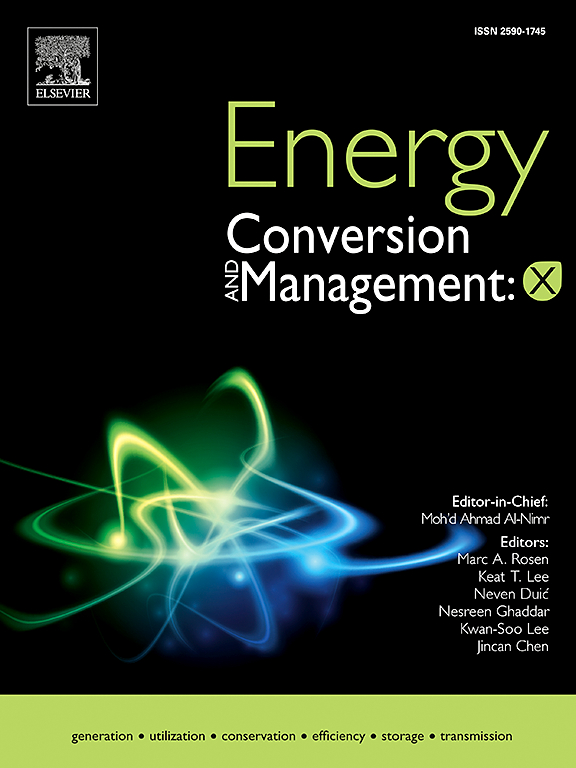Bioethanol manufacturing from industrial olive pomace slurry through integrated hydrothermal carbonisation and non-conventional yeast-based fermentation processes
IF 7.6
Q1 ENERGY & FUELS
引用次数: 0
Abstract
The two-phase olive pomace slurry (TOPS) is the major waste of the olive oil industry. Hydrothermal carbonisation (HTC) has been widely used for the conversion of TOPS into hydrochar, a solid biofuel. The HTC process also co-produces a liquid hydrolysate, whose valorisation has been scarcely investigated. This study focussed on to investigate the composition (reducing sugars, total phenols, acetic acid and furfural) and use of the hydrolysate derived from conventional and microwave assisted HTC of TOPS to produce bioethanol by the fermentation carried out by Hansenula polymorpha, a non-conventional yeast. On the basis of holocellulose content (39.12 %) present in dry TOPS, the optimum conditions to achieve a maximum reducing sugar yield of 25.92 % through conventional HTC were 180 °C and 30 min. In the case of microwave HTC, the optimal conditions were 203 °C and 30 min to obtain a maximum reducing sugar yield of 27.88 %. The HTC also produced total phenols (up to 3.30 %), acetic acid (up to 3.33 %), and furfural (up to 1.96 %). In comparison to conventional HTC, the microwave HTC advantage was generation of lower concentrations of fermentation inhibitors. The H. polymorpha strain produced maximum overall bioethanol yield of 0.21 g g−1 in case of fermentation of liquid hydrolysate at 45 °C with inoculum concentrations of 0.8 g dm−3. These findings emphasised that the HTC of TOPS could be an alternative and promising method for co-production of reducing sugars, bioethanol and total phenols.

通过综合水热碳化和非常规酵母发酵工艺从工业橄榄渣浆中生产生物乙醇
两相橄榄渣浆(TOPS)是橄榄油工业的主要废物。热液碳化(HTC)已被广泛用于将TOPS转化为固体生物燃料——碳氢化合物。HTC过程还共同产生一种液体水解物,其价值几乎没有研究过。本研究的重点是研究TOPS的组成(还原糖、总酚、乙酸和糠醛)以及利用传统和微波辅助HTC的水解液通过非常规酵母Hansenula polymorpha发酵生产生物乙醇。以干燥的稻壳中纤维素含量(39.12%)为基础,常规HTC的最佳条件为180℃,30 min,最大还原糖收率为25.92%。微波HTC的最佳条件为203℃,30 min,最大还原糖收率为27.88%。HTC还生产总酚(高达3.30%),乙酸(高达3.33%)和糠醛(高达1.96%)。与常规HTC相比,微波HTC的优势在于产生较低浓度的发酵抑制剂。在45°C、接种量为0.8 g dm−3的条件下,多态h菌株的水解液发酵总生物乙醇产量最大,为0.21 g g−1。这些发现强调了TOPS的HTC可能是一种有前途的联合生产还原糖、生物乙醇和总酚的替代方法。
本文章由计算机程序翻译,如有差异,请以英文原文为准。
求助全文
约1分钟内获得全文
求助全文
来源期刊

Energy Conversion and Management-X
Multiple-
CiteScore
8.80
自引率
3.20%
发文量
180
审稿时长
58 days
期刊介绍:
Energy Conversion and Management: X is the open access extension of the reputable journal Energy Conversion and Management, serving as a platform for interdisciplinary research on a wide array of critical energy subjects. The journal is dedicated to publishing original contributions and in-depth technical review articles that present groundbreaking research on topics spanning energy generation, utilization, conversion, storage, transmission, conservation, management, and sustainability.
The scope of Energy Conversion and Management: X encompasses various forms of energy, including mechanical, thermal, nuclear, chemical, electromagnetic, magnetic, and electric energy. It addresses all known energy resources, highlighting both conventional sources like fossil fuels and nuclear power, as well as renewable resources such as solar, biomass, hydro, wind, geothermal, and ocean energy.
 求助内容:
求助内容: 应助结果提醒方式:
应助结果提醒方式:


